Ganita Prakash Sample Paper 2026
CBSE class 6 Maths Ganita Prakash Sample Paper for NCERT Textbook Ganita Prakash is an 80-mark question paper. It is divided into 3 sections. The first section has objective-type questions. The second section contains subjective questions, and the third section comprises case study questions.
Class 06 – Maths Ganita Prakash Sample Paper
Maximum: Marks 80
Time Allowed: 3 hours
General Instructions:
- All questions are compulsory.
- The question paper is divided into four sections:
- Section A:
- 10 Multiple choice questions (1 mark each)
- 5 Fill in the blanks questions (1 mark each)
- 5 True/false questions (1 mark each)
- 5 Very short answer type questions (1 mark each)
- Section B:
- 6 Short answer type A questions (2 marks each)
- 5 Short answer type B questions (3 marks each)
- 4 Long answer type questions (5 marks each)
- Section C:
- 2 Case study based questions (4 marks)
- Section A:
-
Section A (Ganita Praksah Sample Paper)
- Choose the correct answers to the questions from the given options.
- A student draws an infographic showing the height of mountains using triangles of different widths. What problem may occur?
a) It may wrongly show that wider means taller
b) It saves time
c) It is a correct method
d) It looks nice
- Which of the following has only 2 lines of symmetry?
a) Equilateral triangle
b) triangle
c) Circle
d) Rhombus
- If the ratio of areas of two squares is 225 : 256, then the ratio of their perimeters is
a) 16 : 15
b) 15 : 16
c) 256 : 225
d) 225 : 256
- What is the length of the side of a square if its diagonal is 10 cm?
a) 10 cm
b) 14 cm
c) 5 cm
d) 7 cm
- Why can pictographs be misleading?
a) Unequal symbols or wrong scales can confuse readers
b) They are colorful
c) They use bars
d) They use symbols
- In a pictograph, what does one symbol usually represent?
a) A number or quantity
b) A drawing
c) A title
d) A color
- The number of degrees in a complete angle is:
a) 360°
b) 90°
c) 180°
d) 270°
- If the length of the diagonal of a square is 20 cm, then its perimeter is
a) 40 cm
b) {tex}10 \sqrt{2 } \mathrm{\ cm}{/tex}
c) 200 cm
d) {tex}40 \sqrt{ 2} \mathrm{~cm}{/tex}
- In which of the following expressions, prime factorization has been done?
a) {tex} 56=1 \times 7 \times 2 \times 2 \times 2 {/tex}
b) {tex} 24=2 \times 3 \times 4 {/tex}
c) {tex} 70=2 \times 5 \times 7 {/tex}
d) {tex} 54=2 \times 3 \times 9 {/tex}
- What is the angle between the diagonals of a square?
a) 45°
b) 60°
c) 120°
d) 90°
- A student draws an infographic showing the height of mountains using triangles of different widths. What problem may occur?
- Fill in the blanks:
- A rectangle ________ has lines of symmetry.
- A ________ has one endpoint and extends endlessly in one direction.
- When creating a geometric pattern using circles and lines, choosing a good ________ helps make the design visually appealing and symmetrical.
- A line of ________ divides a figure into two similar parts.
- In a grid, a number is a supercell only if it is greater than its ________ neighbours.
- State whether each of the following statement is True or False:
- A rectangle can be constructed using only the length of one side.
- A number cannot have more than 150 multiples.
- If A, B, C and D are collinear points D, P and Q are collinear, then points A, B, C, D, P and Q are always collinear.
- You can only create circular shapes in geometric artwork.
- A regular pentagon has 5 lines of symmetry.
- Answer any FIVE of the following questions:
- Construct a line segment EF with a length of 10.2 cm. From EF, cut off EG, which measures 3.8 cm. Determine the length of FG.
- Define Frequency distribution.
- Number of words in your maths textbook:
- More than 5000
- Less than 5000
- Mark three non-collinear points A, B and C in your note book. Draw lines through these points taking two at a time. Name these lines. How many such different lines can be drawn?
- Suppose you start with ₹ 0 in your bank account, and then you have debits of ₹ 1, 2, 4, 8, 16, 32, 64, and 128, and then a single credit of ₹ 256. What is your bank account balance now?
- Find the prime factorisations of the following numbers: 64, 104, 105, 243, 320, 141, 1728, 729, 1024, 1331, 1000.
-
Section B (Ganita Praksah Sample Paper)
- Answer any SIX of the following questions:
- Amita read 60 pages of a book containing 140 pages while Aarushi read {tex}\frac{2}{5}{/tex} of the book. Who read more pages?
- In a figure, 60o is the smallest angle of symmetry. What are the other angles of symmetry of this figure?
- A marble tile measures 15 cm {tex}\times{/tex} 20 cm. How many tiles will be required to cover a wall of size 4 m {tex}\times{/tex} 6 m?
- The outline of the new parliament building in India is shown. Construct a single line segment that equals the total length of any two sides in the given shape using a ruler and compass.
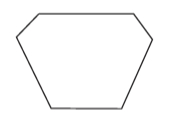
- Following is the choice of sweets of 30 students of class VI: Ladoo, Barfi, Ladoo, Jalebi, Ladoo, Rasgulla, Jalebi, Ladoo, Barfi, Rasgulla, Ladoo, Jalebi, Jalebi, Rasgulla, Ladoo, Rasgulla, Jalebi, Ladoo, Rasgulla, Ladoo, Rasgulla, Jalebi, Ladoo, Rasgulla, Ladoo, Ladoo, Barfi, Rasgulla, Rasgulla, Ladoo.
- Arrange the names of sweets in a table using tally marks.
- Which sweet is preferred by most of the students?
- Write a five-digit number and a four-digit number such that their difference is a four-digit number.
- Give three examples of angles from your environment.
- Answer any FIVE of the following questions:
- Which of the following pairs of numbers are twin-primes?
- 17,19
- 59,61
- 43,47
- 97,101
- Why are 1, 3, 6, 10, 15, 21, 28, 36, … called triangular numbers?
- Express each of the following mixed fractions as improper fractions:
- {tex}3 \frac{2}{7}{/tex}
- {tex}4 \frac{5}{9}{/tex}
- {tex}3 \frac{2}{5}{/tex}
- In the following figures, identify the figure that has:
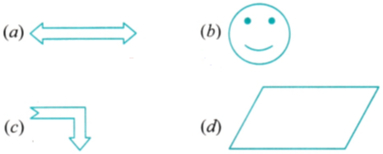
- line of symmetry
- rotational symmetry
- both line of symmetry and rotational symmetry
- neither line of symmetry nor rotational symmetry
- Find the perimeter of a rectangular field whose length is four times its width and which has an area equal to {tex}30976 {~cm}^2{/tex}.
- Test the divisibility of the following numbers by 6:
- 7020
- 56423
- 732510
- Which of the following pairs of numbers are twin-primes?
- Answer any FOUR of the following questions:
- Why can’t all five children in a height-based sequence say ‘1’?
- Write the following mixed numbers as fractions:
- {tex}3 \frac{1}{4}{/tex}
- {tex}7 \frac{2}{3}{/tex}
- {tex} 9 \frac{4}{9}{/tex}
- {tex}3 \frac{1}{6}{/tex}
- {tex}2 \frac{3}{11}{/tex}
- {tex}3 \frac{9}{10}{/tex}
- Minimum, how many unit squares will you colour so that the figure has:
- only one line of symmetry?
- two lines of symmetry?
- four lines of symmetry?
- only a horizontal line of symmetry?
- Find the areas of the figures below by dividing them into rectangles and triangles.
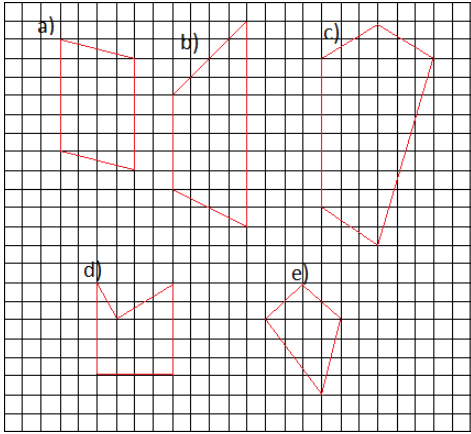
- Draw a rectangle with sides of length 4 cm and 6 cm. After drawing, check if it satisfies both the rectangle properties.
-
Section C (Ganita Praksah Sample Paper)
- Answer the following Case Study based questions:
- Read the following text carefully and answer the questions that follow:
On a 12-hour clock, certain times form palindromic patterns. For example, 12 : 21 is a palindromic time because it reads the same backward as forward. Other examples include 1 : 01, 2 : 12, and 3 : 03. These times are called palindromic because the sequence of digits is the same when reversed. Students can identify such times by checking if the hour and minute digits are symmetrical. This activity helps in understanding patterns and timekeeping in a creative way.- What is the next palindromic time after 10 : 01? (1)
- How many minutes are there between 12 : 21 and the next palindromic time? (1)
- List all the palindromic times between 1 : 00 and 2 : 00. (2)
OR
Explain why 11 : 11 is a palindromic time. (2)
- Read the following text carefully and answer the questions that follow:
Rohan is using a compass to draw circles in his geometry class. He notices that when he opens the compass, the two arms form an angle. He wonders how the size of the angle affects the circle he draws. He also observes that the compass can form different types of angles, such as acute, obtuse, and right angles.- What is the vertex of the angle formed by the compass arms? (1)
- If Rohan opens the compass to form a right angle, what is the measure of this angle in degrees? (1)
- Explain how the size of the angle formed by the compass arms affects the circle drawn. (2)
OR
If Rohan opens the compass to form an angle of 45°, what type of angle is this? Justify your answer. (2)
- Read the following text carefully and answer the questions that follow:
Class 06 – Ganita Prakash Sample Paper
Section A Ganita Prakash Sample Paper
- Choose the correct answers to the questions from the given options.
- (a) It may wrongly show that wider means tallerExplanation: Width and height must not confuse the actual data meaning.
- (d) RhombusExplanation: Rhombus
- (b) 15 : 16Explanation: Consider ABCD and PQRS as the two squares.
Let the lengths of each side of {tex}A B C D{/tex} and {tex}P Q R S{/tex} be {tex}x{/tex} and {tex}y{/tex}.
We know that
Area of sq. {tex}A B C D{/tex} /Area of sq. {tex}P Q R S=x^2 / y^2{/tex}
So we get {tex}x^2 / y^2=225 / 256{/tex}
By taking square roots on both sides,
{tex} x / y=15 / 16 {/tex}
By taking the ratio of their perimeters, we get
Perimeter of sq. {tex}{ABCD} /{/tex}Perimeter of sq. {tex}{PQRS}=(4 \times{/tex} side of sq. ABCD{tex}) /(4 \times{/tex} side of sq. PQRS) = {tex}4 {x} / 4 {y}{/tex}
By removing common terms in numerator and denominator
Perimeter of sq. {tex}A B C D /{/tex}Perimeter of sq. {tex}P Q R S=x / y{/tex}
So perimeter of sq. {tex}A B C D /{/tex}Perimeter of sq. {tex}P Q R S=15 / 16{/tex}
Hence, the ratio of their perimeters {tex}=15: 16{/tex} - (d) 7 cmExplanation: 7 cm (using Pythagoras theorem, side = diagonal/{tex}\sqrt 2 \approx 7{/tex})
- (a) Unequal symbols or wrong scales can confuse readersExplanation: Consistency and clear scales are needed to avoid misinterpretation.
- (a) A number or quantityExplanation: Each picture or symbol in a pictograph stands for one or more data values.
- (a) 360°Explanation: 360°
- (d) {tex}40 \sqrt{ 2} \mathrm{~cm}{/tex}Explanation: It is given that length of the diagonal {tex}=20 \mathrm{~cm}{/tex}
So the length of the side of a square {tex}={/tex} Length of Diagonal {tex}/ \sqrt{2 } =20 / \sqrt{2 } =(2 \times 10) / \sqrt{ 2}{/tex}
We get
Length of the side of a square {tex}=(\sqrt{ 2} \times \sqrt{ 2} \times 10) / \sqrt{2 } =10 \sqrt{ 2} \mathrm{~cm}{/tex}
Hence, perimeter of the square {tex}=4 \times{/tex} Side {tex}=4 \times 10 \sqrt{ } 2=40 \sqrt{ } 2 \mathrm{~cm}{/tex} - (c) {tex} 70=2 \times 5 \times 7 {/tex}Explanation: {tex} 70=2 \times 5 \times 7 {/tex}
- (d) 90°Explanation: 90°
- Fill in the blanks:
- infinite
- ray
- center
- symmetry
- adjacent (left, right, top, and bottom)
- State whether each of the following statement is True or False:
- False
-
False
-
False
-
False
-
True
- Answer any FIVE of the following questions:
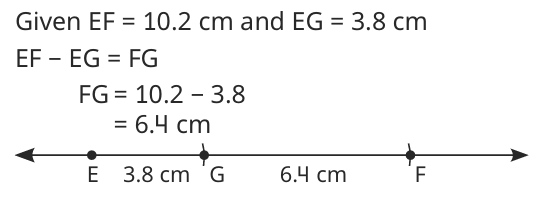
- Frequency table or frequency distribution is a method to present raw data in the form from which one can easily understand the information contained in the raw data.
- More than 5000
Most textbooks contain well over 5000 words, considering explanations, exercises, and examples.
- More than 5000
- AB, BC, AC, Three lines
- 0 (initial balance) + 256 (credit) – 1 (debit) – 2 (debit) – 4 (debit) – 8 (debit) – 16 (debit) – 32 (debit) – 64 (debit) – 128 (debit)
Simplifying the expression: 0 + 256 – 255
=
Therefore, your bank account balance now is ₹ 1.
- {tex}64=2^6{/tex}
- {tex}104=2^3 \times 13{/tex}
- {tex}105=3 \times 5 \times 7{/tex}
- {tex}243=3^5{/tex}
- {tex}320=2^6 \times 5{/tex}
- {tex}141=3 \times 47{/tex}
- {tex}1728=2^6 \times 3^3{/tex}
- {tex}729=3^6{/tex}
- {tex}1024=2^{10}{/tex}
- {tex}1331=11^3{/tex}
- {tex}1000=2^3 \times 5^3{/tex}
-
Section B Ganita Prakash Sample Paper
- Answer any SIX of the following questions:
- Pages read by Amita:
Already given {tex}=60{/tex} pages
Pages read by Aarushi:
{tex} \frac{2}{5} \times 140=\frac{280}{5}=56\ \text{pages} {/tex}
Compare:
Amita read 60 pages and Aarushi read 56 pages.
Since {tex}60>56{/tex}:
Amita read more pages. - If 60 degrees is the smallest angle of symmetry, then the other angles of symmetry are multiples of 60 degrees.
This is because if the figure can be rotated 60 degrees to map onto itself, it can also be rotated 120 degrees, 180 degrees, 240 degrees, and so on.
Therefore, the complete list of angles of symmetry for this figure would be:- 60 degrees
- 120 degrees
- 180 degrees
- 240 degrees
- 300 degrees
- 360 degrees (which is always a rotational symmetry for any figure)
- Measure of marble tile = 15 cm {tex}\times{/tex} 20 cm
Size of wall = 4 m × 6 m = 400 cm {tex}\times{/tex} 600 cm
So we get area of tile = 15 cm {tex}\times{/tex} 20 cm = 300 cm2
Area of wall = 400 cm {tex}\times{/tex} 600 cm = 240000 cm2
No. of tiles required to cover the wall = Area of wall/ Area of one tile
Substituting the values
No. of tiles required to cover the wall = 240000/300 = 800 tiles
Hence, 800 tiles are required to cover a wall of size 4 m {tex}\times{/tex} 6 m. 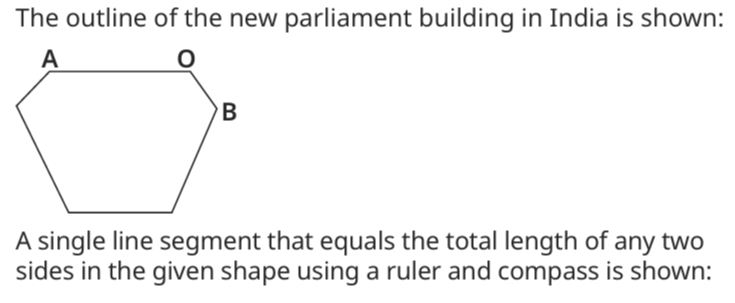

- Frequency table of sweets given to 30 students is as follows:
Sweets Tally Marks Frequency Ladoo {tex}\cancel {||||}{/tex} {tex}\cancel {||||}{/tex} || 12 Burfi ||| 3 Jalebi {tex}\cancel {||||}{/tex} | 6 Rasgulla {tex}\cancel {||||}{/tex} |||| 9 - From the table we know that ladoo has the maximum frequency
Hence, ladoo is the sweet which is preferred by most of the students.
- Frequency table of sweets given to 30 students is as follows:
- Five-digit number: 15000
Four-digit number: 5678
Difference: 9312- Corner of a notebook or book – forms a right angle (90o)
- Open door – forms an acute or obtuse angle depending on how much it is opened
- Hands of a clock – form different angles (e.g., 90o at 3 o’clock, 180o at 6 o’clock)
- Pages read by Amita:
- Answer any FIVE of the following questions:
- If the difference between a pair of prime numbers is 2, then the pair is pair of twin-primes, otherwise not.
- We find that 17 and 19 are prime numbers such that {tex}19-17=2{/tex}. So, 17,19 is a pair of twin-primes.
- We observe that 59 and 61 are prime numbers such that {tex}61-59=2{/tex}. So, 59,61 is a pair of twin-primes.
- Note that 43 and 47 are prime numbers such that {tex}47-43 \neq 2{/tex}. So, they do not form a pair of twin-primes.
- We notice that 97 and 101 are primes but their difference is not 2. So, it is not a pair of twin-primes.
- Numbers like {tex}1,4,9,16,25,36, \ldots{/tex} are called square numbers because they are made by multiplying a number by itself (like {tex}1 \times 1,2 \times 2,3 \times 3{/tex}, etc.) and can form a perfect square shape.
- We have,
- {tex} 3 \frac{2}{7}=\frac{3 \times 7+2}{7}=\frac{21+2}{7}=\frac{23}{7} {/tex}
- {tex} 4 \frac{5}{9}=\frac{4 \times 9+5}{9}=\frac{36+5}{9}=\frac{41}{9} {/tex}
- {tex} 3 \frac{2}{5}=\frac{3 \times 5+2}{5}=\frac{15+2}{5}=\frac{17}{5} {/tex}
- Figures (a) and (b) have line of symmetry.
- Figures (a) and (d) have rotational symmetry.
- Figures (a) has both line of symmetry and rotational symmetry.
- Figures (c) has neither line of symmetry nor rotational symmetry.
- Let the width of the field be {tex}b {~cm}{/tex}. Then,
Length of the field {tex}=4 b {~cm}{/tex}
{tex}\therefore {/tex} Area of the field {tex}=(b \times 4 b) {cm}^2=4 b^2 {~cm}^2{/tex}
But, area of the field is given as {tex}30976 {~cm}^2{/tex}
{tex} \therefore 4 b^2=30976 {/tex}
{tex} \Rightarrow b^2=\frac{30976}{4}=7744 {/tex} {tex}\Rightarrow b \times b=88 \times 88 \Rightarrow b{/tex} = 88
{tex} \therefore \text { Length of the field }=4 b {~cm}{/tex} {tex}=(4 \times 88) {cm}=352 {~cm} {/tex}
{tex} \text { Width of the field }=b {~cm}=88 {~cm} {/tex}
Hence, Perimeter of the field = {tex}2(\text { Length }+ \text { Breadth }) {/tex}
{tex} =2(352+88) {cm}=880 {~cm} {/tex}- 7020 Last digit {tex}=0 \rightarrow{/tex} divisible by 2.
Sum of digits {tex}=7+0+2+0=9\Rightarrow{/tex} divisible by 3.
So, 7020 is divisible by 6. - 56423
Last digit {tex}=3\rightarrow{/tex} not divisible by 2.
So, no need to check further.
{tex}56423{/tex} is not divisible by 6. - 732510
Last digit {tex}=0\rightarrow{/tex} divisible by 2.
Sum of digits {tex}=7+3+2+5+1+0=18\rightarrow{/tex} divisible by 3.
So, 732510 is divisible by 6.
- 7020 Last digit {tex}=0 \rightarrow{/tex} divisible by 2.
- If the difference between a pair of prime numbers is 2, then the pair is pair of twin-primes, otherwise not.
- Answer any FOUR of the following questions:
- Each child says the number of taller children standing next to them. If all five children say ‘1’, it means each child has exactly one taller neighbor on both sides.
This is impossible because:- The two children at the ends would also need a taller child next to them, which is not possible.
- If the end children say ‘1’, it implies a taller child exists beyond the line.
Thus, a sequence like 1,1,1,1,1 cannot be achieved in a group of 5 children. - Here {tex}3 \frac{1}{4}=3+\frac{1}{4}{/tex}
[Splitting {tex}3 \frac{1}{4}{/tex} into 3 and {tex}\frac{1}{4}{/tex} ] {tex} =1+1+1+\frac{1}{4} {/tex}
{tex} =\frac{4}{4}+\frac{4}{4}+\frac{4}{4}+\frac{1}{4}=\frac{13}{4} {/tex} - Here {tex}7 \frac{2}{3}=7+\frac{2}{3}{/tex}
[Splitting {tex}7 \frac{2}{3}{/tex} into 7 and {tex}\frac{2}{3}{/tex} ] {tex} =1+1+1+1+1+1+1+\frac{2}{3} {/tex}
{tex} =\frac{3}{3}+\frac{3}{3}+\frac{3}{3}+\frac{3}{3}+\frac{3}{3}+\frac{3}{3}+\frac{3}{3}+\frac{2}{3} {/tex}
{tex} =\frac{23}{3} {/tex} - Here {tex}9 \frac{4}{9}=9+\frac{4}{9}{/tex}
[Splitting {tex}9 \frac{4}{9}{/tex} into 9 and {tex}\frac{4}{9}{/tex} ] {tex} =9 \text { times } \frac{9}{9}+\frac{4}{9} {/tex}
{tex} =\frac{81}{9}+\frac{4}{9}=\frac{85}{9} {/tex} - Here
{tex} 3 \frac{1}{6}=3+\frac{1}{6}{/tex}
[Splitting {tex}3 \frac{1}{6}{/tex} into 3 and {tex}\frac{1}{6}{/tex} ] {tex} =3 \operatorname{times} \frac{6}{6}+\frac{1}{6} {/tex}
{tex} =\frac{18}{6}+\frac{1}{6} {/tex}
{tex} =\frac{19}{6} {/tex} - {tex} \text { We have } 2 \frac{3}{11}=2+\frac{3}{11} {/tex}
{tex} {\left[\text { Splitting } 2 \frac{3}{11} \text { into } 2 \text { and } \frac{3}{11} \text { ] }\right.} {/tex}
{tex} =2 \text { times } \frac{11}{11}+\frac{3}{11} {/tex}
{tex} =\frac{22}{11}+\frac{3}{11} {/tex}
{tex} =\frac{25}{11} {/tex} - {tex} 3 \frac{9}{10}=3+\frac{9}{10} {/tex}
{tex} \text { [Splitting } 3 \frac{9}{10} \text { into } 3 \text { and } \frac{9}{10} \text { ] } {/tex}
{tex} =3 \text { times } \frac{10}{10}+\frac{9}{10} {/tex}
{tex} =\frac{30}{10}+\frac{9}{10}=\frac{39}{10} {/tex} - One unit square will be coloured to have only one line of symmetry.
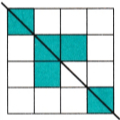
- Two unit squares will be coloured to have two lines of symmetry.
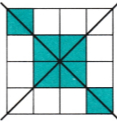
- Four unit squares will be coloured to have four lines.
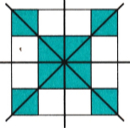
- Two unit squares will be coloured to have only a horizontal line of symmetry.
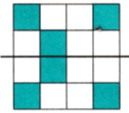
- Let, the 1 square = 1 square unit
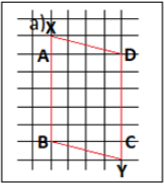
Length of rectangle ABCD = 5 units
Width of rectangle ABCD = 4 units
So, area of rectangle ABCD = 5 {tex}\times{/tex} 4 square units = 20 sq units
Now, Height of triangle AXD = 1 unit
Base of triangle AXD = 4 units
So, the area of triangle AXD = {tex}\frac 12\times 1 \times 4{/tex} sq units = 2sq units
As same as the area of triangle BCY = 2 sq units
Hence, the area of the figure XBYD = (20 + 2 + 2) sq units = 24 sq units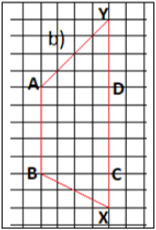
Area of rectangle ABCD = 5 {tex}\times{/tex} 4 sq units = 20 sq units
Area of triangle BCX = {tex}\frac 12\times 2 \times 4{/tex} sq units = 4 sq units
Area of triangle ADY = {tex}\frac 12\times 4 \times 4{/tex} sq units = 8 sq units
So, the area of the figure ABXY = (20 + 4 + 8) sq units = 32sq units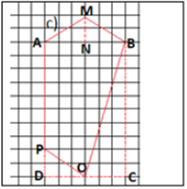
Area of the rectangle ABCD = 6 {tex}\times{/tex} 10 sq units = 60 sq units
Area of triangle BCO = {tex}\frac 12{/tex} {tex}\times{/tex} 10 {tex}\times{/tex} 3 sq units = 15 sq units
Area of triangle PDO = {tex}\frac 12{/tex} {tex}\times{/tex} 2 {tex}\times{/tex} 3 sq units = 3 sq units
So, the area of figure ABOP = Area of the rectangle ABCD – (Area of triangle BCO + Area of triangle PDO)
{tex}\therefore{/tex} Area of figure ABOP = 60 – (15 + 3) sq units = 42 sq units
Now, Area of triangle AMN = {tex}\frac 12{/tex} {tex}\times{/tex} 2 {tex}\times{/tex} 3 sq units = 3 sq units
{tex}\therefore{/tex} Area of triangle MNB = {tex}\frac 12{/tex} × 2 × 3 sq units = 3 sq units
Hence, area of the figure AMBOP = (42 + 6) sq units = 48 sq units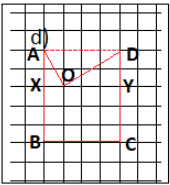
Area of rectangle XBCY = 3 {tex}\times{/tex} 4 sq units = 12 sq units
Area of triangle AXO = {tex}\frac 12{/tex} {tex}\times{/tex} 2 {tex}\times{/tex} 1 sq units = 1 sq units
Area of triangle DOY = {tex}\frac 12{/tex} {tex}\times{/tex} 2 {tex}\times{/tex} 3 sq units = 3 sq units
Hence, the area of the figure ABCDO = (12 + 1 + 3) sq units = 16 sq units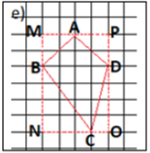
Area of rectangle MNOP = 6 {tex}\times{/tex} 4 sq units = 24 sq units
Area of triangle MBA = {tex}\frac 12{/tex} {tex}\times{/tex} 2 {tex}\times{/tex} 2 sq units = 2 sq units
Area of triangle ADP = {tex}\frac 12{/tex} {tex}\times{/tex} 2 {tex}\times{/tex} 2 sq units = 2 sq units
Area of triangle BNC = {tex}\frac 12{/tex} {tex}\times{/tex} 4 {tex}\times{/tex} 3 sq units = 6 sq units
Area of triangle DOC = {tex}\frac 12{/tex} {tex}\times{/tex} 4 {tex}\times{/tex} 1 sq units = 2 sq units
So, the area of figure ABCD = Area of rectangle MNOP – Area of other 4 triangle
{tex}\therefore{/tex} Area of figure ABCD = 24 – (2 + 2 + 6 + 2) sq units = 12 sq units
- We shall draw a rectangle of the form shown in Fig. 1.
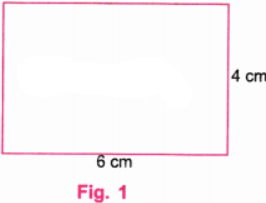
Step 1. Using a ruler, draw a line AB equal to 6 cm. (Fig. 2)

Step 2. Using a protractor, draw perpendicular lines at A and B (Fig. 3)
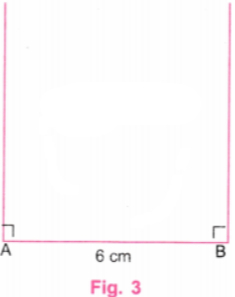
Step 3. Using a ruler, mark point P on the perpendicular line at A such that AP = 4 cm. Using a ruler, mark point Q on the perpendicular line at B such that BQ = 4 cm. (Fig. 4).
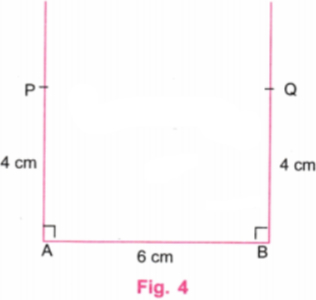
Step 4. Join P and Q using a ruler. Erase the lines above P and Q. (Fig. 5).
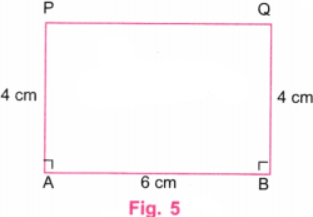
Step 5. Using a ruler, verify that PQ is of length 6 cm.
Using a protractor, verify that {tex}\angle{/tex}P and {tex}\angle{/tex}Q are 90° each.
Step 6. We have:- AB = PQ = 6 cm and AP = BQ = 4 cm
- {tex}\angle{/tex}A = {tex}\angle{/tex}B = {tex}\angle{/tex}Q = {tex}\angle{/tex}P = 90°.
Step 7. ABQP in Fig. 5 is the required rectangle of sides 4 cm and 6 cm.
- Each child says the number of taller children standing next to them. If all five children say ‘1’, it means each child has exactly one taller neighbor on both sides.
-
Section C Ganita Prakash Sample Paper
- Answer the following Case Study based questions:
-
- The next palindromic time after 10 : 01 is 10 : 01.
- There are 10 minutes between 12 : 21 and the next palindromic time, which is 12 : 21.
- The palindromic times between 1 : 00 and 2 : 00 are 1 : 01, 1 : 11, and 1 : 21.
OR
11 : 11 is a palindromic time because it reads the same backward as forward. - The vertex of the angle is the point where the two arms of the compass meet.
- The measure of a right angle is 90°.
- The size of the angle formed by the compass arms determines the radius of the circle. A larger angle will result in a larger circle, while a smaller angle will result in a smaller circle.
OR
An angle of 45° is an acute angle because it is less than 90°.
-

Test Generator
Create question paper PDF and online tests with your own name & logo in minutes.
Create Now
Learn8 App
Practice unlimited questions for Entrance tests & government job exams at ₹99 only
Install Now